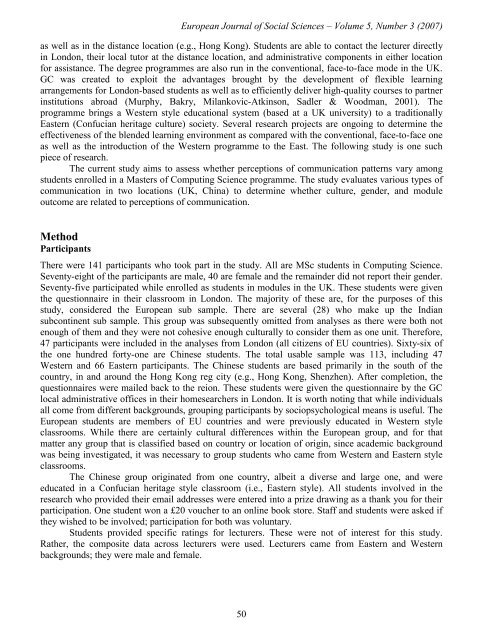european journal of social sciences issn: 1450-2267 - EuroJournals
european journal of social sciences issn: 1450-2267 - EuroJournals
european journal of social sciences issn: 1450-2267 - EuroJournals
Create successful ePaper yourself
Turn your PDF publications into a flip-book with our unique Google optimized e-Paper software.
European Journal <strong>of</strong> Social Sciences – Volume 5, Number 3 (2007)<br />
as well as in the distance location (e.g., Hong Kong). Students are able to contact the lecturer directly<br />
in London, their local tutor at the distance location, and administrative components in either location<br />
for assistance. The degree programmes are also run in the conventional, face-to-face mode in the UK.<br />
GC was created to exploit the advantages brought by the development <strong>of</strong> flexible learning<br />
arrangements for London-based students as well as to efficiently deliver high-quality courses to partner<br />
institutions abroad (Murphy, Bakry, Milankovic-Atkinson, Sadler & Woodman, 2001). The<br />
programme brings a Western style educational system (based at a UK university) to a traditionally<br />
Eastern (Confucian heritage culture) society. Several research projects are ongoing to determine the<br />
effectiveness <strong>of</strong> the blended learning environment as compared with the conventional, face-to-face one<br />
as well as the introduction <strong>of</strong> the Western programme to the East. The following study is one such<br />
piece <strong>of</strong> research.<br />
The current study aims to assess whether perceptions <strong>of</strong> communication patterns vary among<br />
students enrolled in a Masters <strong>of</strong> Computing Science programme. The study evaluates various types <strong>of</strong><br />
communication in two locations (UK, China) to determine whether culture, gender, and module<br />
outcome are related to perceptions <strong>of</strong> communication.<br />
Method<br />
Participants<br />
There were 141 participants who took part in the study. All are MSc students in Computing Science.<br />
Seventy-eight <strong>of</strong> the participants are male, 40 are female and the remainder did not report their gender.<br />
Seventy-five participated while enrolled as students in modules in the UK. These students were given<br />
the questionnaire in their classroom in London. The majority <strong>of</strong> these are, for the purposes <strong>of</strong> this<br />
study, considered the European sub sample. There are several (28) who make up the Indian<br />
subcontinent sub sample. This group was subsequently omitted from analyses as there were both not<br />
enough <strong>of</strong> them and they were not cohesive enough culturally to consider them as one unit. Therefore,<br />
47 participants were included in the analyses from London (all citizens <strong>of</strong> EU countries). Sixty-six <strong>of</strong><br />
the one hundred forty-one are Chinese students. The total usable sample was 113, including 47<br />
Western and 66 Eastern participants. The Chinese students are based primarily in the south <strong>of</strong> the<br />
country, in and around the Hong Kong reg city (e.g., Hong Kong, Shenzhen). After completion, the<br />
questionnaires were mailed back to the reion. These students were given the questionnaire by the GC<br />
local administrative <strong>of</strong>fices in their homesearchers in London. It is worth noting that while individuals<br />
all come from different backgrounds, grouping participants by sociopsychological means is useful. The<br />
European students are members <strong>of</strong> EU countries and were previously educated in Western style<br />
classrooms. While there are certainly cultural differences within the European group, and for that<br />
matter any group that is classified based on country or location <strong>of</strong> origin, since academic background<br />
was being investigated, it was necessary to group students who came from Western and Eastern style<br />
classrooms.<br />
The Chinese group originated from one country, albeit a diverse and large one, and were<br />
educated in a Confucian heritage style classroom (i.e., Eastern style). All students involved in the<br />
research who provided their email addresses were entered into a prize drawing as a thank you for their<br />
participation. One student won a £20 voucher to an online book store. Staff and students were asked if<br />
they wished to be involved; participation for both was voluntary.<br />
Students provided specific ratings for lecturers. These were not <strong>of</strong> interest for this study.<br />
Rather, the composite data across lecturers were used. Lecturers came from Eastern and Western<br />
backgrounds; they were male and female.<br />
50

















